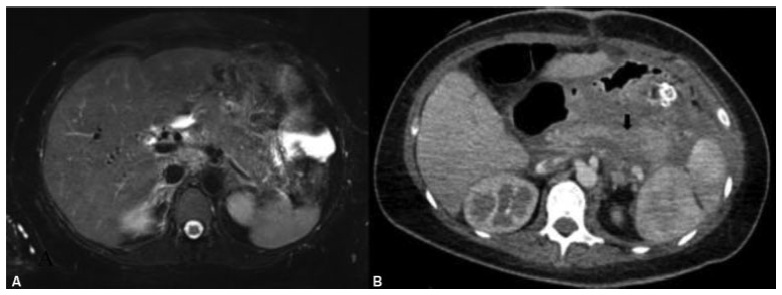Summary
Revista Brasileira de Ginecologia e Obstetrícia. 2021;43(7):570-577
Sacral colpopexy is one of the standard procedures to treat apical pelvic organ prolapse. In most cases, a synthetic mesh is used to facilitate the colposuspension. Spondylodiscitis is a rare but potentially serious complication that must be promptly diagnosed and treated, despite the lack of consensus in the management of this complication.We report one case of spondylodiscitis after a laparoscopic supracervical hysterectomy and sacral colpopexy treated conservatively. We also present a literature review regarding this rare complication. A conservative approach without mesh removal may be possible in selected patients (stable, with no vaginal lesions, mesh exposure or severe neurologic compromise). Hemocultures and culture of imageguided biopsies should be performed to direct antibiotic therapy. Conservative versus surgical treatment should be regularly weighted depending on clinical and analytical progression. A multidisciplinary team is of paramount importance in the follow-up of these patients.

Summary
Revista Brasileira de Ginecologia e Obstetrícia. 2021;43(5):414-416
The diagnosis of genital ulcers remains a challenge in clinical practice. Lipschütz ulcer is a non-sexually transmitted rare and, probably, underdiagnosed condition, characterized by the sudden onset of vulvar edema along with painful necrotic ulcerations. Despite its unknown incidence, this seems to be an uncommon entity, with sparse cases reported in the literature. We report the case of an 11-year-old girl who presented at the emergency department with vulvar ulcers. She denied any sexual intercourse. The investigation excluded sexually transmitted infections, so, knowledge of different etiologies of non-venereal ulcers became essential. The differential diagnoses are extensive and include inflammatory processes, drug reactions, trauma, and malignant tumors. Lipschütz ulcer is a diagnosis of exclusion. With the presentation of this case report, the authors aim to describe the etiology, clinical course, and outcomes of this rare disease, to allow differential diagnosis of genital ulceration.

Summary
Revista Brasileira de Ginecologia e Obstetrícia. 2021;43(4):323-328
Complete hydatidiform mole (CHM) is a rare type of pregnancy, in which 15 to 20% of the cases may develop into gestational trophoblastic neoplasia (GTN). The diagnostic of GTN must be done as early as possible through weekly surveillance of serum hCG after uterine evacuation.We report the case of 23-year-old primigravida, with CHM but without surveillance of hCG after uterine evacuation. Two months later, the patient presented to the emergency with vaginal bleeding and was referred to the Centro de Doenças Trofoblásticas do Hospital São Paulo. She was diagnosed with high risk GTN stage/score III:7 as per The International Federation of Gynecology and Obstetrics/World Health Organization (FIGO/WHO). The sonographic examination revealed enlarged uterus with a heterogeneous mass constituted of multiple large vessels invading and causing disarrangement of the myometrium. The patient evolved with progressive worsening of vaginal bleeding after chemotherapy with etoposide, methotrexate, actinomycin D, cyclophosphamide and vincristine (EMA-CO) regimen. She underwent blood transfusion and embolization of uterine arteries due to severe vaginal hemorrhage episodes, with complete control of bleeding. The hCG reached a negative value after the third cycle, and there was a complete regression of the anomalous vascularization of the uterus as well as full recovery of the uterine anatomy. The treatment in a reference center was essential for the appropriate management, especially regarding the uterine arteries embolization trough percutaneous femoral
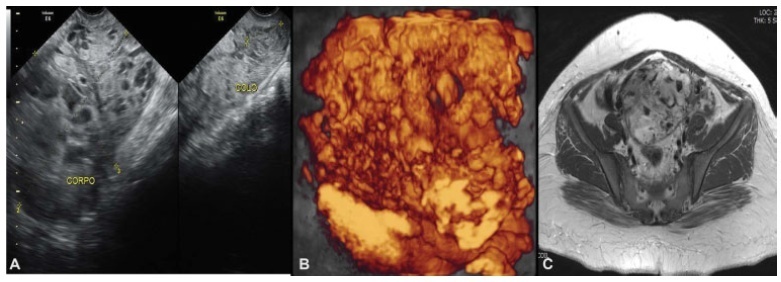
Summary
Revista Brasileira de Ginecologia e Obstetrícia. 2021;43(4):317-322
Fetal thyroid complications in pregnancy are uncommon, and are commonly related to the passage of substances through the placenta. The excessive iodine intake during the pregnancy is a well-known mechanism of fetal thyroid enlargement or goiter, and invasive procedures have been proposed for the treatment of fetal thyroid pathologies. In the present report, we demonstrate two cases from different centers of prenatal diagnosis of fetal thyroid enlargement and/or goiter in three fetuses (one pair of twins, wherein both fetuses were affected, and one singleton pregnancy). The anamnesis revealed the ingestion of iodine by the patients, prescribed from inadequate vitamin supplementation. In both cases, the cessation of iodine supplement intake resulted in a marked reduction of the volume of the fetal thyroid glands, demonstrating that conservative treatmentmay be an option in those cases. Also, clinicians must be aware that patients may be exposed to harmful dosages or substances during pregnancy.
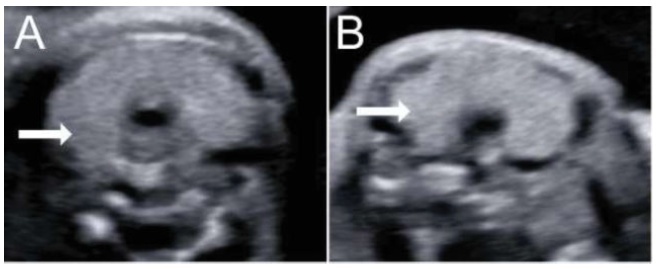
Summary
Revista Brasileira de Ginecologia e Obstetrícia. 2021;43(4):311-316
A cesarean scar pregnancy (CSP) is a scary and life-threatening complication of cesarean section (CS). Nevertheless, the incidence of CS is constantly growing. The CSP incidence is 0,15% of pregnancies after CS which represents 6,1% of all ectopic pregnancies in women with condition after CS. Therefore, it should be more present in the clinical daily routine. From mild nonspecific symptoms to hypovolemic shock, diagnosis and therapy must be performed quickly. With the progressive growth of the scar pregnancy, a uterine rupture involves the risk of severe bleeding, and an emergency hysterectomy could be necessary. Prolongation of pregnancy has been successful only in a few cases.We report 11 cases from our hospital in the past 10 years. In the discussion, treatment options of this complication with an increasing incidence, which is associated with serious morbidity and mortality, are presented based on the current literature. Treatment options include drug therapy, but also surgical or combined procedures with radiological intervention.
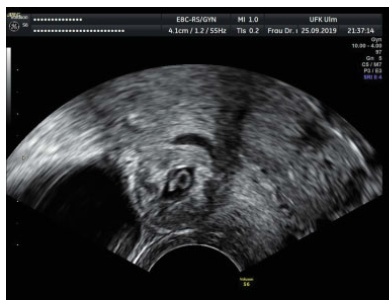
Summary
Revista Brasileira de Ginecologia e Obstetrícia. 2021;43(4):329-333
Malignant mesonephric tumors are uncommon in the female genital tract, and they are usually located where embryonic remnants of Wolffian ducts are detected, such as the uterine cervix. The information about these tumors, their treatment protocol, and prognosis are scarce.
A 60-year-old woman with postmenopausal vaginal bleeding was initially diagnosed with endometrial carcinoma. After suspicion co-testing, the patient underwent a loop electrosurgical excision of the cervix and was eventually diagnosed with mesonephric adenocarcinoma. She was subjected to a radical hysterectomy, which revealed International Federation of Gynecology and Obstetrics (FIGO) IB1 stage, and adjuvant radiotherapy. The follow-up showed no evidence of recurrence after 60 months.
We present the case of a woman with cervical mesonephric adenocarcinoma. When compared with the literature, this case had the longest clinical follow-up without evidence of recurrence, which reinforces the concept that these tumors are associated with a favorable prognosis if managed according to the guidelines defined for the treatment of patients with cervical adenocarcinomas. Though a rare entity, it should be kept in mind as a differential diagnosis for other cervical cancers.
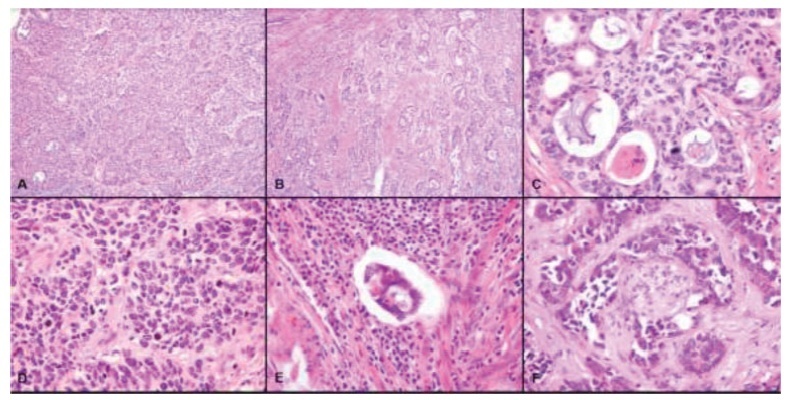
Summary
Revista Brasileira de Ginecologia e Obstetrícia. 2021;43(1):66-71
Uterine leiomyoma is themost prevalent benign type of gynecological tumor. It affects more than 80% of women worldwide and, within this group, more than 50% may be asymptomatic. However, large fibroid volumes may be associated with symptoms of extrinsic compression, and most of the cases do not present atypical cells. We present the case of a 49-year-old woman who underwent a total abdominal hysterectomy of a 13.5-kg uterine leiomyoma with no malignancies at histopathology and review the literature about giant uterine leiomyomas and their clinical repercussion. We concluded that large volumes do not always pose a threat regarding malignancy; however, future molecular studies are needed to investigate giant uterine fibroids.
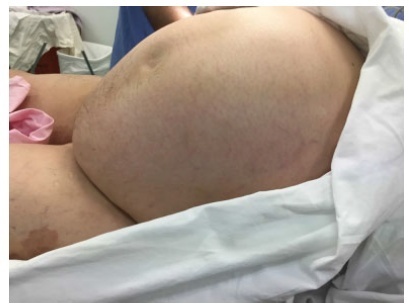
Summary
Revista Brasileira de Ginecologia e Obstetrícia. 2021;43(3):220-224
Acute pancreatitis is a rare condition in pregnancy, associated with a high mortality rate. Hypertriglyceridemia represents its second most common cause.We present the case of a 38-year-old woman in the 24th week of gestation with a history of hypertriglyceridemia and recurrent episodes of pancreatitis. She was admitted to our hospital with acute pancreatitis due to severe hypertriglyceridemia. She was stabilized and treated with fibrates. Despite her favorable clinical course, she developed a second episode of acute pancreatitis complicated by multi-organ dysfunction and pancreatic necrosis, requiring a necrosectomy. The pregnancy was ended by cesarean section, after which three plasmapheresis sessions were performed. She is currently asymptomatic with stable triglyceride levels. Acute pancreatitis due to hypertriglyceridemia represents a diagnostic and therapeutic challenge in pregnant women, associated with serious maternal and fetal complications. When primary hypertriglyceridemia is suspected, such as familial chylomicronemia syndrome, the most important objective is preventing the onset of pancreatitis.
